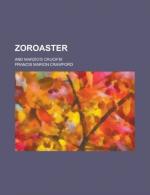Zoroaster sat by the spring and watched the crystal waters sparkle in the brief hour of sunshine at noonday, and turn dark and deep again when the light was gone. He moved not through the long hours of day, sitting as he had sat in that place now for three years neither scorched by the short hours of sunlight, nor chilled by winter’s frost and snow. The wild long-haired sheep of the mountain came down to drink at noon, and timidly gazed with their stupid eyes at the immovable figure; and at evening the long-bodied, fierce-eyed wolves would steal stealthily among the rocks and come and snuff the ground about his feet, presently raising their pointed heads with a long howl of fear, and galloping away through the dusk in terror, as though at something unearthly.
And when at last the night was come, Zoroaster arose and went to the spot where the rocks, overhanging together, left a space through which one might enter; and the white-haired man gave one long look at the stars overhead, and disappeared within.
There was a vast cave, the roof reaching high up in a great vault; the sides black and polished, as though smoothed by the hands of cunning workmen; the floor a bed of soft, black sand, dry and even as the untrodden desert. In the midst, a boulder of black rock lay like a huge ball, and upon its summit burned a fire that was never quenched, and that needed no replenishing with fuel. The tall pointed flame shed a strangely white light around, that flashed and sparkled upon the smooth black walls of the cavern, as though they were mirrors. The flame also was immovable; it neither flickered, nor rose, nor fell; but stood as it were a spear-head of incandescent gold upon the centre of the dark altar. There was no smoke from that strange fire, nor any heat near it, as from other fires.
Then Zoroaster bent and put forth his forefinger and traced a figure upon the sand, which was like a circle, save that it was cut from north-west to south-east by two straight lines; and from north-east to south-west by two straight lines; and at each of the four small arcs, where the straight lines cut the circumference of the great circle, a part of a smaller circle outside the great one united the points over each other. And upon the east side, toward the altar, the great circle was not joined, but open for a short distance.[5]
[Footnote 5: The
Mazdayashnian Dakhma, or place of death. This
figure represents the
ground-plan of the modern Parsi Tower of
Silence.]
When the figure was traced, Zoroaster came out from it and touched the black rock whereon the fire burned; and then he turned back and entered the circle, and with his fingers joined it where it was open on the east side through which he had entered. And immediately, as the circle was completed, there sprung up over the whole line he had traced a soft light; like that of the fire, but less strong. Then Zoroaster lay down upon his back, with his feet to the west and his head toward the altar, and he folded his hands upon his breast and closed his eyes. As he lay, his body became rigid and his face as the face of the dead; and his spirit was loosed in the trance and freed from the bonds of earth, while his limbs rested.




